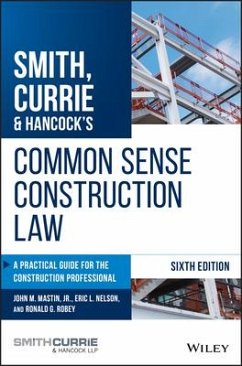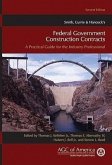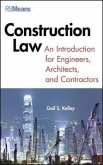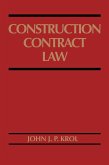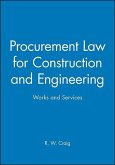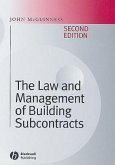John M Mastin, Eric L Nelson, Ronald G Robey, Smith Currie & Hancock Llp
Smith, Currie & Hancock's Common Sense Construction Law
A Practical Guide for the Construction Professional
John M Mastin, Eric L Nelson, Ronald G Robey, Smith Currie & Hancock Llp
Smith, Currie & Hancock's Common Sense Construction Law
A Practical Guide for the Construction Professional
- Gebundenes Buch
- Merkliste
- Auf die Merkliste
- Bewerten Bewerten
- Teilen
- Produkt teilen
- Produkterinnerung
- Produkterinnerung
The #1 construction law guide for construction professionals Updated and expanded to reflect the most recent changes in construction law, this practical guide teaches readers the difficult theories, principles, and established rules that regulate the construction business. It addresses the practical steps required to avoid and mitigate risks--whether the project is performed domestically or internationally, or whether it uses a traditional design-bid-build delivery system or one of the many alternative project delivery systems. Smith, Currie & Hancock's Common Sense Construction Law: A…mehr
Andere Kunden interessierten sich auch für
![Smith, Currie & Hancock's Federal Government Construction Contracts Smith, Currie & Hancock's Federal Government Construction Contracts]() Thomas J KelleherSmith, Currie & Hancock's Federal Government Construction Contracts146,99 €
Thomas J KelleherSmith, Currie & Hancock's Federal Government Construction Contracts146,99 €![Construction Law Construction Law]() Gail KelleyConstruction Law137,99 €
Gail KelleyConstruction Law137,99 €![Construction Contract Law Construction Contract Law]() John J P KrolConstruction Contract Law203,99 €
John J P KrolConstruction Contract Law203,99 €![Building Facades: A Guide to Common Defects in Tropical Climates Building Facades: A Guide to Common Defects in Tropical Climates]() Yit Lin Michael ChewBuilding Facades: A Guide to Common Defects in Tropical Climates48,99 €
Yit Lin Michael ChewBuilding Facades: A Guide to Common Defects in Tropical Climates48,99 €![Procurement Law for Construction and Engineering Procurement Law for Construction and Engineering]() R W CraigProcurement Law for Construction and Engineering423,99 €
R W CraigProcurement Law for Construction and Engineering423,99 €![The Law and Management of Building Subcontracts The Law and Management of Building Subcontracts]() John McguinnessThe Law and Management of Building Subcontracts153,99 €
John McguinnessThe Law and Management of Building Subcontracts153,99 €![Chern on Dispute Boards Chern on Dispute Boards]() Cyril ChernChern on Dispute Boards268,99 €
Cyril ChernChern on Dispute Boards268,99 €-
-
-
The #1 construction law guide for construction professionals Updated and expanded to reflect the most recent changes in construction law, this practical guide teaches readers the difficult theories, principles, and established rules that regulate the construction business. It addresses the practical steps required to avoid and mitigate risks--whether the project is performed domestically or internationally, or whether it uses a traditional design-bid-build delivery system or one of the many alternative project delivery systems. Smith, Currie & Hancock's Common Sense Construction Law: A Practical Guide for the Construction Professional provides a comprehensive introduction to the important legal topics and questions affecting the construction industry today. This latest edition features: all-new coverage of Electronically Stored Information (ESI) and Integrated Project Delivery (IPD); extended information on the civil False Claims Act; and fully updated references to current AIA, ConsensusDocs, DBIA, and EJDC contract documents. Chapters cover the legal context of construction; interpreting a contract; public-private partnerships (P3); design-build and EPC; and international construction contracts. Other topics include: management techniques to limit risks and avoid disputes; proving costs and damages, including for changes and claims for delay and disruption; construction insurance, including general liability, builders risk, professional liability, OCIP, CCIP, and OPPI; bankruptcy; federal government construction contracting; and more. * Fully updated with comprehensive coverage of the significant legal topics and questions that affect the construction industry * Discusses new project delivery methods including Public-Private Partnerships (P3) and Integrated Project Delivery (IPD) * Presents new coverage of digital tools and processes including Electronically Stored Information (ESI) * Provides extended and updated coverage of the civil False Claims Act as it relates to government construction contracting Filled with checklists, sample forms, and summary "Points to Remember" for each chapter, Smith, Currie & Hancock's Common Sense Construction Law: A Practical Guide for the Construction Professional, Sixth Edition is the perfect resource for construction firm managers, contractors, subcontractors, architects, and engineers. It will also greatly benefit students in construction management, civil engineering, and architecture.
Hinweis: Dieser Artikel kann nur an eine deutsche Lieferadresse ausgeliefert werden.
Hinweis: Dieser Artikel kann nur an eine deutsche Lieferadresse ausgeliefert werden.
Produktdetails
- Produktdetails
- Verlag: Wiley
- 6th edition
- Seitenzahl: 768
- Erscheinungstermin: 1. Oktober 2019
- Englisch
- Abmessung: 254mm x 180mm x 30mm
- Gewicht: 1202g
- ISBN-13: 9781119540175
- ISBN-10: 1119540178
- Artikelnr.: 55773537
- Herstellerkennzeichnung
- Libri GmbH
- Europaallee 1
- 36244 Bad Hersfeld
- gpsr@libri.de
- Verlag: Wiley
- 6th edition
- Seitenzahl: 768
- Erscheinungstermin: 1. Oktober 2019
- Englisch
- Abmessung: 254mm x 180mm x 30mm
- Gewicht: 1202g
- ISBN-13: 9781119540175
- ISBN-10: 1119540178
- Artikelnr.: 55773537
- Herstellerkennzeichnung
- Libri GmbH
- Europaallee 1
- 36244 Bad Hersfeld
- gpsr@libri.de
SMITH, CURRIE & HANCOCK LLP was founded in 1965. With offices in Atlanta, Georgia; Charlotte and Raleigh, North Carolina; Fort Lauderdale, Florida; San Francisco, California; Tysons, Virginia; and Washington, D.C., the firm has nationally recognized practices in the areas of construction law, construction insurance, government contracts, and environmental law. The firm represents clients in all 50 states, as well as Puerto Rico, Mexico, Canada, Central America, South America, Europe, Africa, and Asia. JOHN M. MASTIN, JR. is a Partner at Smith, Currie & Hancock LLP. John has extensive, real-world experience in construction design and engineering, as well as the resolution of construction disputes involving, among other things, contract interpretation, contract changes, schedule delays, acceleration, differing site conditions, and proving costs and damages. ERIC L. NELSON is a Partner at Smith, Currie & Hancock LLP. Eric practices in the areas of construction law, energy, federal construction procurements, infrastructure, and healthcare markets. He has extensive experience with U.S. federal construction issues, such as the False Claims Act, small business programs, cost and pricing, compliance, Miller Act, Green and sustainable construction, and requests for equitable adjustments and claims. RONALD G. ROBEY is a Partner at Smith, Currie & Hancock LLP. Ronald specializes in the areas of construction law, insurance, and government contracts and has extensive experience with small and disadvantaged business issues in the federal and state procurement systems and with false claims in federal and in state procurement.
Preface xxv
Author Biographies xxvii
1 The Legal Context of Construction 1
I. Introduction 1
II. Contract Law 1
III. Evolution of Construction Law 3
IV. Torts 4
V. Statutory and Regulatory Laws Affecting the Business of Construction 7
2 Interpreting the Contract 11
I. The Importance of Contract Interpretation 11
II. What is a Contract? 11
III. The Goal of Contract Interpretation 12
IV. Defining Contract Terms 12
V. Interpreting the Contract's Language 13
VI. The Facts and Circumstances Surrounding Contract Formation 15
VII. Resolving Ambiguities 18
VIII. Implied Contractual Obligations 19
IX. Contractual Obligations Arising by Operation of Law 23
3 Alternative Contracting Methods 26
I. Traditional Approach to Construction: Advantages and Disadvantages 26
II. Integrated Project Delivery 27
III. Multiprime Contracting and Fast-Tracking 31
IV. Construction Management 32
V. Design-Build Contracting 35
VI. Design-Build Aspects of Traditional Construction 43
VII. Contractor Liability Issues 47
VIII. Engineer-Procure-Construct 48
IX. Building Information Modeling 51
4 Public-Private Partnerships 56
I. The P3 Alternative 57
II. P3 Project Participants 64
III. P3 Financing Strategies 68
IV. P3 Risk Allocation 73
V. Conclusion 77
5 International Construction Contracts 79
I. Unique Issues 79
II. Project Delivery Methods and Contract Forms 81
III. Dispute Resolution 92
6 Working in a Different State 96
I. Qualifying to Do Business 96
II. State Registration Requirements: Bonds to Secure Payment of Taxes 97
III. State Licensing and Qualifications 98
IV. Public-Sector Construction 99
V. State Statutes and Policies Affecting Contractual Relationships and
Terms 101
VI. Preservation of Lien/Bond Rights 107
VII. Project Risk Assessment-"Foreign States" 109
VIII. Information Sources 110
Appendix 6.1 Checklist: Projects in "Foreign Jurisdictions" 112
7 Competing for the Contract 115
I. Introduction: The Rationale for Competition 115
II. Key Concepts in Traditional Public Competitive Bids-Responsiveness and
Responsibility 116
III. The "Lowest and Best" Bidder 122
IV. Negotiated "Best Value" Selection Process 124
V. Electronic Bids 126
VI. Reverse Auctions 128
VII. General Considerations When Competing on Private Contracts 129
VIII. Effect of Past Performance Evaluations on Award Process 130
IX. Contractor Bid Mistakes 136
X. Bid Protests on State or Local Government Contracts 140
XI. Bid Bonds 142
XII. "Bid Shopping": What is the Prime Contractor's Obligation to the
Subcontractor Submitting the Lowest Price? 144
XIII. Holding Subcontractors and Vendors to Their Bids 146
XIV. Statute of Frauds Issues 149
XV. Damages 150
8 The Uniform Commercial Code and the Construction Industry 152
I. Applicability to Construction Projects-Purchasing Equipment and
Materials 152
II. Determining When Article 2 Applies 153
III. Modifying U.C.C. Obligations 153
IV. Contract Formation Under the U.C.C. 154
V. Risk of Loss 156
VI. Inspection, Acceptance, Rejection, and Revocation of Acceptance 157
VII. Warranties Under the U.C.C. 160
VIII. Statute of Limitations and Commencement of the Warranty Period 162
IX. Performance Issues 164
9 The Design Professional's Authority and Responsibility 169
I. Overview 169
II. Standard of Care, Professional Responsibility, and Liability 169
III. The Design Professional's Authority 176
IV. The Design Professional's Administrative Functions 179
V. The Design Professional's Other Duties 189
VI. The Design Professional's Liability to the Contractor and Third Parties
190
VII. Statutes of Repose 196
VIII. Effects of Contractual Limitations on Design Professional Liability
198
IX. Assumption of Design Liability by the Contractor 201
X. Shared Responsibility and Risk 203
XI. The Design Professional's Copyright for Design Documents 205
10 Subcontract Administration and Dispute Avoidance 209
I. Dispute Avoidance Begins at the Bidding Stage 209
II. The Subcontract Agreement 214
III. Should Subcontractors Be Bonded? 233
IV. Dispute Avoidance by Diligent Project Administration 234
11 Contract Changes 245
I. What is a Changes Clause? 245
II. Recovery Under the Changes Clause 251
III. Constructive Changes 259
IV. Cardinal Changes 264
V. The Impact of Numerous Changes on Unchanged Work 266
VI. Impossibility/Impracticability 266
12 Differing Site Conditions 269
I. "Differing Site Condition" Defined 269
II. Responsibility for Differing Site Conditions 269
III. Standard Industry Differing Site Conditions Clauses 270
IV. Comparison of Differing Site Condition Provisions 277
V. Operation of the Differing Site Conditions Clause 279
VI. Stumbling Blocks to Recovery 288
VII. Relief in the Absence of a Contract Provision 294
Appendices-Site Investigation Checklists 299
Appendix 12.1 Project Checklist: Qualifying the Site 300
Exhibit A: Site Investigation Record 301
Appendix 12.2 Pre-Bid Environmental Considerations 303
13 Schedules, Delays, and Acceleration 305
I. Allocating the Risk of Performance Time in the Contract 306
II. Use of Schedules in Project Management 311
III. Analysis of Project Delay 314
IV. Typical Causes of Compensable Delay 316
V. Concurrent Delay 322
VI. Excusable but Noncompensable Delays 323
VII. Acceleration 325
VIII. Contractual Limitations to Recovery for Delays 327
IX. Owner Claims for Delay 330
X. Delay Claims and the Use of CPM Schedules 331
XI. Documentation to Support Delay Claims 332
14 Inspection, Acceptance, Warranties, and Commissioning 337
I. Inspection 338
II. Acceptance 348
III. Contractual Warranties 355
IV. Project Commissioning and Post-Acceptance Facility Operations 359
15 Management Techniques to Limit Risks and Avoid Disputes 364
I. Construction: A Risk-Prone Business 364
II. Qualifying the Project and the Participants 365
III. Defining Rights, Responsibilities, and Risks: Parties and Their
Contracts 371
IV. Contract Framework 372
V. Avoiding and Preparing for Disputes Through Proper Management and
Documentation 376
VI. Prudent and Responsible Estimating 376
VII. Establish Standard Operating Procedures 377
VIII. Establish Lines of Communication 378
IX. Project Documentation 378
X. Electronic Communications on Construction Projects 383
XI. Cost Accounting Records 387
XII. Monitoring the Work through Scheduling 388
XIII. Preserving Electronically Stored Information 389
XIV. Conclusion 390
Appendix 15.1 ConsensusDocs 221-Contractor's Statement of Qualifications
for a Specific Project 391
Appendix 15.2 Logs and Forms 406
Appendix 15.2A Format for Notice Checklist 407
Appendix 15.2B Sample Partial Notice Checklists 409
Appendix 15.2C Forms 413
Appendix 15.2D Request for Information 418
Appendix 15.2E Telephone Conversation Memorandum 419
Appendix 15.2F Sample Daily Report 420
Appendix 15.2G Notice of Backcharge 421
Appendix 15.2H Field Order Status Chart 422
Appendix 15.2I Log: Incoming Correspondence 423
Appendix 15.2J Log: Outgoing Correspondence 424
16 Payment Bonds 425
I. Payment Bonds Required by Statute 426
II. Payment Bonds on Private Projects 431
III. Who is Protected by Payment Bonds 432
IV. Work Qualifying for Payment Bond Coverage 437
V. Recovery Under Payment Bonds for Extra Work, Delay Damages, or Lost
Profits and Other Costs 439
VI. Distinguishing between Payment Bond Claims and Performance Bond Claims
441
VII. Procedural Requirements for Payment Bonds 442
VIII. Effect of Payment Bonds on Lien Rights 446
IX. The Surety's Defenses to Payment Bond Liability 446
17 Performance Bonds and Terminations 451
I. Surety Performance Bonds 451
II. Termination 465
18 Proving Costs and Damages 480
I. Basic Damage Principles 480
II. Methods of Pricing Claims 485
III. Contractor Damages 488
IV. Owner Damages 502
19 An Overview of Environmental and Safety Concerns on the Construction
Site 509
I. Sources of Environmental Regulation and Liability 509
II. Minimizing Environmental Risks Prior to Contracting 518
III. Management Techniques for Environmental Risks during Contract
Performance 523
IV. Mold: Developing a Program to Limit Liability 525
V. Environmentally Friendly Construction: Green Buildings 526
VI. Construction Safety 530
20 Construction Insurance 540
I. Importance of Insurance Planning 540
II. Introduction to the Language of Insurance Policies 541
III. Types of Insurance 543
IV. Contract Requirements for Insurance 548
V. Prompt Action to Protect Potential Coverage 551
VI. Insurer's Response to Claims 552
VII. Routine Coverage Issues 553
VIII. Concurrent Causes 559
IX. Construction Insurance and Mold Claims 560
21 Labor and Employment Issues Affecting the Construction Industry 566
I. Immigration Issues 566
II. Employee Safety and Health 571
III. Wage and Hour Requirements 572
IV. Employee Benefits: ERISA 581
V. Employment Discrimination 583
VI. Family and Medical Leave Act 588
VII. Union Labor 590
VIII. Employee-Background Investigations 590
IX. Workers' Compensation-Exclusive Remedy Assertions 593
22 Bankruptcy in the Construction Setting 595
I. Introduction 595
II. The Players 595
III. Key Terms 596
IV. Bankruptcy Code 598
V. Status of the Debtor's Contracts 606
VI. Status of Materials and Equipment 610
VII. Status of Contract Funds 613
VIII. Other Sources of Funds 617
23 Resolving Construction Disputes 623
I. Early Claim Recognition and Preparation 624
II. Early Involvement of Experts and Attorneys 625
III. Demonstrative Evidence 626
IV. Contemporaneous Records 627
V. Components of a Well-Prepared Claim Document 627
VI. Calculating and Proving Damages 629
VII. Pursuing Negotiation and Settlement 630
VIII. Arbitration 633
IX. Litigation 643
24 Federal Government Construction Contracting-An Overview 651
I. Introduction: The Key Differences 651
II. Contractor Selection 656
III. Social-Economic Policies 663
IV. Resolution of Contract Disputes 684
V. Standards of Conduct for Contractors 694
Appendix 24.1 Internet Resources for Federal Government Construction
Contracts 704
Index 705
Author Biographies xxvii
1 The Legal Context of Construction 1
I. Introduction 1
II. Contract Law 1
III. Evolution of Construction Law 3
IV. Torts 4
V. Statutory and Regulatory Laws Affecting the Business of Construction 7
2 Interpreting the Contract 11
I. The Importance of Contract Interpretation 11
II. What is a Contract? 11
III. The Goal of Contract Interpretation 12
IV. Defining Contract Terms 12
V. Interpreting the Contract's Language 13
VI. The Facts and Circumstances Surrounding Contract Formation 15
VII. Resolving Ambiguities 18
VIII. Implied Contractual Obligations 19
IX. Contractual Obligations Arising by Operation of Law 23
3 Alternative Contracting Methods 26
I. Traditional Approach to Construction: Advantages and Disadvantages 26
II. Integrated Project Delivery 27
III. Multiprime Contracting and Fast-Tracking 31
IV. Construction Management 32
V. Design-Build Contracting 35
VI. Design-Build Aspects of Traditional Construction 43
VII. Contractor Liability Issues 47
VIII. Engineer-Procure-Construct 48
IX. Building Information Modeling 51
4 Public-Private Partnerships 56
I. The P3 Alternative 57
II. P3 Project Participants 64
III. P3 Financing Strategies 68
IV. P3 Risk Allocation 73
V. Conclusion 77
5 International Construction Contracts 79
I. Unique Issues 79
II. Project Delivery Methods and Contract Forms 81
III. Dispute Resolution 92
6 Working in a Different State 96
I. Qualifying to Do Business 96
II. State Registration Requirements: Bonds to Secure Payment of Taxes 97
III. State Licensing and Qualifications 98
IV. Public-Sector Construction 99
V. State Statutes and Policies Affecting Contractual Relationships and
Terms 101
VI. Preservation of Lien/Bond Rights 107
VII. Project Risk Assessment-"Foreign States" 109
VIII. Information Sources 110
Appendix 6.1 Checklist: Projects in "Foreign Jurisdictions" 112
7 Competing for the Contract 115
I. Introduction: The Rationale for Competition 115
II. Key Concepts in Traditional Public Competitive Bids-Responsiveness and
Responsibility 116
III. The "Lowest and Best" Bidder 122
IV. Negotiated "Best Value" Selection Process 124
V. Electronic Bids 126
VI. Reverse Auctions 128
VII. General Considerations When Competing on Private Contracts 129
VIII. Effect of Past Performance Evaluations on Award Process 130
IX. Contractor Bid Mistakes 136
X. Bid Protests on State or Local Government Contracts 140
XI. Bid Bonds 142
XII. "Bid Shopping": What is the Prime Contractor's Obligation to the
Subcontractor Submitting the Lowest Price? 144
XIII. Holding Subcontractors and Vendors to Their Bids 146
XIV. Statute of Frauds Issues 149
XV. Damages 150
8 The Uniform Commercial Code and the Construction Industry 152
I. Applicability to Construction Projects-Purchasing Equipment and
Materials 152
II. Determining When Article 2 Applies 153
III. Modifying U.C.C. Obligations 153
IV. Contract Formation Under the U.C.C. 154
V. Risk of Loss 156
VI. Inspection, Acceptance, Rejection, and Revocation of Acceptance 157
VII. Warranties Under the U.C.C. 160
VIII. Statute of Limitations and Commencement of the Warranty Period 162
IX. Performance Issues 164
9 The Design Professional's Authority and Responsibility 169
I. Overview 169
II. Standard of Care, Professional Responsibility, and Liability 169
III. The Design Professional's Authority 176
IV. The Design Professional's Administrative Functions 179
V. The Design Professional's Other Duties 189
VI. The Design Professional's Liability to the Contractor and Third Parties
190
VII. Statutes of Repose 196
VIII. Effects of Contractual Limitations on Design Professional Liability
198
IX. Assumption of Design Liability by the Contractor 201
X. Shared Responsibility and Risk 203
XI. The Design Professional's Copyright for Design Documents 205
10 Subcontract Administration and Dispute Avoidance 209
I. Dispute Avoidance Begins at the Bidding Stage 209
II. The Subcontract Agreement 214
III. Should Subcontractors Be Bonded? 233
IV. Dispute Avoidance by Diligent Project Administration 234
11 Contract Changes 245
I. What is a Changes Clause? 245
II. Recovery Under the Changes Clause 251
III. Constructive Changes 259
IV. Cardinal Changes 264
V. The Impact of Numerous Changes on Unchanged Work 266
VI. Impossibility/Impracticability 266
12 Differing Site Conditions 269
I. "Differing Site Condition" Defined 269
II. Responsibility for Differing Site Conditions 269
III. Standard Industry Differing Site Conditions Clauses 270
IV. Comparison of Differing Site Condition Provisions 277
V. Operation of the Differing Site Conditions Clause 279
VI. Stumbling Blocks to Recovery 288
VII. Relief in the Absence of a Contract Provision 294
Appendices-Site Investigation Checklists 299
Appendix 12.1 Project Checklist: Qualifying the Site 300
Exhibit A: Site Investigation Record 301
Appendix 12.2 Pre-Bid Environmental Considerations 303
13 Schedules, Delays, and Acceleration 305
I. Allocating the Risk of Performance Time in the Contract 306
II. Use of Schedules in Project Management 311
III. Analysis of Project Delay 314
IV. Typical Causes of Compensable Delay 316
V. Concurrent Delay 322
VI. Excusable but Noncompensable Delays 323
VII. Acceleration 325
VIII. Contractual Limitations to Recovery for Delays 327
IX. Owner Claims for Delay 330
X. Delay Claims and the Use of CPM Schedules 331
XI. Documentation to Support Delay Claims 332
14 Inspection, Acceptance, Warranties, and Commissioning 337
I. Inspection 338
II. Acceptance 348
III. Contractual Warranties 355
IV. Project Commissioning and Post-Acceptance Facility Operations 359
15 Management Techniques to Limit Risks and Avoid Disputes 364
I. Construction: A Risk-Prone Business 364
II. Qualifying the Project and the Participants 365
III. Defining Rights, Responsibilities, and Risks: Parties and Their
Contracts 371
IV. Contract Framework 372
V. Avoiding and Preparing for Disputes Through Proper Management and
Documentation 376
VI. Prudent and Responsible Estimating 376
VII. Establish Standard Operating Procedures 377
VIII. Establish Lines of Communication 378
IX. Project Documentation 378
X. Electronic Communications on Construction Projects 383
XI. Cost Accounting Records 387
XII. Monitoring the Work through Scheduling 388
XIII. Preserving Electronically Stored Information 389
XIV. Conclusion 390
Appendix 15.1 ConsensusDocs 221-Contractor's Statement of Qualifications
for a Specific Project 391
Appendix 15.2 Logs and Forms 406
Appendix 15.2A Format for Notice Checklist 407
Appendix 15.2B Sample Partial Notice Checklists 409
Appendix 15.2C Forms 413
Appendix 15.2D Request for Information 418
Appendix 15.2E Telephone Conversation Memorandum 419
Appendix 15.2F Sample Daily Report 420
Appendix 15.2G Notice of Backcharge 421
Appendix 15.2H Field Order Status Chart 422
Appendix 15.2I Log: Incoming Correspondence 423
Appendix 15.2J Log: Outgoing Correspondence 424
16 Payment Bonds 425
I. Payment Bonds Required by Statute 426
II. Payment Bonds on Private Projects 431
III. Who is Protected by Payment Bonds 432
IV. Work Qualifying for Payment Bond Coverage 437
V. Recovery Under Payment Bonds for Extra Work, Delay Damages, or Lost
Profits and Other Costs 439
VI. Distinguishing between Payment Bond Claims and Performance Bond Claims
441
VII. Procedural Requirements for Payment Bonds 442
VIII. Effect of Payment Bonds on Lien Rights 446
IX. The Surety's Defenses to Payment Bond Liability 446
17 Performance Bonds and Terminations 451
I. Surety Performance Bonds 451
II. Termination 465
18 Proving Costs and Damages 480
I. Basic Damage Principles 480
II. Methods of Pricing Claims 485
III. Contractor Damages 488
IV. Owner Damages 502
19 An Overview of Environmental and Safety Concerns on the Construction
Site 509
I. Sources of Environmental Regulation and Liability 509
II. Minimizing Environmental Risks Prior to Contracting 518
III. Management Techniques for Environmental Risks during Contract
Performance 523
IV. Mold: Developing a Program to Limit Liability 525
V. Environmentally Friendly Construction: Green Buildings 526
VI. Construction Safety 530
20 Construction Insurance 540
I. Importance of Insurance Planning 540
II. Introduction to the Language of Insurance Policies 541
III. Types of Insurance 543
IV. Contract Requirements for Insurance 548
V. Prompt Action to Protect Potential Coverage 551
VI. Insurer's Response to Claims 552
VII. Routine Coverage Issues 553
VIII. Concurrent Causes 559
IX. Construction Insurance and Mold Claims 560
21 Labor and Employment Issues Affecting the Construction Industry 566
I. Immigration Issues 566
II. Employee Safety and Health 571
III. Wage and Hour Requirements 572
IV. Employee Benefits: ERISA 581
V. Employment Discrimination 583
VI. Family and Medical Leave Act 588
VII. Union Labor 590
VIII. Employee-Background Investigations 590
IX. Workers' Compensation-Exclusive Remedy Assertions 593
22 Bankruptcy in the Construction Setting 595
I. Introduction 595
II. The Players 595
III. Key Terms 596
IV. Bankruptcy Code 598
V. Status of the Debtor's Contracts 606
VI. Status of Materials and Equipment 610
VII. Status of Contract Funds 613
VIII. Other Sources of Funds 617
23 Resolving Construction Disputes 623
I. Early Claim Recognition and Preparation 624
II. Early Involvement of Experts and Attorneys 625
III. Demonstrative Evidence 626
IV. Contemporaneous Records 627
V. Components of a Well-Prepared Claim Document 627
VI. Calculating and Proving Damages 629
VII. Pursuing Negotiation and Settlement 630
VIII. Arbitration 633
IX. Litigation 643
24 Federal Government Construction Contracting-An Overview 651
I. Introduction: The Key Differences 651
II. Contractor Selection 656
III. Social-Economic Policies 663
IV. Resolution of Contract Disputes 684
V. Standards of Conduct for Contractors 694
Appendix 24.1 Internet Resources for Federal Government Construction
Contracts 704
Index 705
Preface xxv
Author Biographies xxvii
1 The Legal Context of Construction 1
I. Introduction 1
II. Contract Law 1
III. Evolution of Construction Law 3
IV. Torts 4
V. Statutory and Regulatory Laws Affecting the Business of Construction 7
2 Interpreting the Contract 11
I. The Importance of Contract Interpretation 11
II. What is a Contract? 11
III. The Goal of Contract Interpretation 12
IV. Defining Contract Terms 12
V. Interpreting the Contract's Language 13
VI. The Facts and Circumstances Surrounding Contract Formation 15
VII. Resolving Ambiguities 18
VIII. Implied Contractual Obligations 19
IX. Contractual Obligations Arising by Operation of Law 23
3 Alternative Contracting Methods 26
I. Traditional Approach to Construction: Advantages and Disadvantages 26
II. Integrated Project Delivery 27
III. Multiprime Contracting and Fast-Tracking 31
IV. Construction Management 32
V. Design-Build Contracting 35
VI. Design-Build Aspects of Traditional Construction 43
VII. Contractor Liability Issues 47
VIII. Engineer-Procure-Construct 48
IX. Building Information Modeling 51
4 Public-Private Partnerships 56
I. The P3 Alternative 57
II. P3 Project Participants 64
III. P3 Financing Strategies 68
IV. P3 Risk Allocation 73
V. Conclusion 77
5 International Construction Contracts 79
I. Unique Issues 79
II. Project Delivery Methods and Contract Forms 81
III. Dispute Resolution 92
6 Working in a Different State 96
I. Qualifying to Do Business 96
II. State Registration Requirements: Bonds to Secure Payment of Taxes 97
III. State Licensing and Qualifications 98
IV. Public-Sector Construction 99
V. State Statutes and Policies Affecting Contractual Relationships and
Terms 101
VI. Preservation of Lien/Bond Rights 107
VII. Project Risk Assessment-"Foreign States" 109
VIII. Information Sources 110
Appendix 6.1 Checklist: Projects in "Foreign Jurisdictions" 112
7 Competing for the Contract 115
I. Introduction: The Rationale for Competition 115
II. Key Concepts in Traditional Public Competitive Bids-Responsiveness and
Responsibility 116
III. The "Lowest and Best" Bidder 122
IV. Negotiated "Best Value" Selection Process 124
V. Electronic Bids 126
VI. Reverse Auctions 128
VII. General Considerations When Competing on Private Contracts 129
VIII. Effect of Past Performance Evaluations on Award Process 130
IX. Contractor Bid Mistakes 136
X. Bid Protests on State or Local Government Contracts 140
XI. Bid Bonds 142
XII. "Bid Shopping": What is the Prime Contractor's Obligation to the
Subcontractor Submitting the Lowest Price? 144
XIII. Holding Subcontractors and Vendors to Their Bids 146
XIV. Statute of Frauds Issues 149
XV. Damages 150
8 The Uniform Commercial Code and the Construction Industry 152
I. Applicability to Construction Projects-Purchasing Equipment and
Materials 152
II. Determining When Article 2 Applies 153
III. Modifying U.C.C. Obligations 153
IV. Contract Formation Under the U.C.C. 154
V. Risk of Loss 156
VI. Inspection, Acceptance, Rejection, and Revocation of Acceptance 157
VII. Warranties Under the U.C.C. 160
VIII. Statute of Limitations and Commencement of the Warranty Period 162
IX. Performance Issues 164
9 The Design Professional's Authority and Responsibility 169
I. Overview 169
II. Standard of Care, Professional Responsibility, and Liability 169
III. The Design Professional's Authority 176
IV. The Design Professional's Administrative Functions 179
V. The Design Professional's Other Duties 189
VI. The Design Professional's Liability to the Contractor and Third Parties
190
VII. Statutes of Repose 196
VIII. Effects of Contractual Limitations on Design Professional Liability
198
IX. Assumption of Design Liability by the Contractor 201
X. Shared Responsibility and Risk 203
XI. The Design Professional's Copyright for Design Documents 205
10 Subcontract Administration and Dispute Avoidance 209
I. Dispute Avoidance Begins at the Bidding Stage 209
II. The Subcontract Agreement 214
III. Should Subcontractors Be Bonded? 233
IV. Dispute Avoidance by Diligent Project Administration 234
11 Contract Changes 245
I. What is a Changes Clause? 245
II. Recovery Under the Changes Clause 251
III. Constructive Changes 259
IV. Cardinal Changes 264
V. The Impact of Numerous Changes on Unchanged Work 266
VI. Impossibility/Impracticability 266
12 Differing Site Conditions 269
I. "Differing Site Condition" Defined 269
II. Responsibility for Differing Site Conditions 269
III. Standard Industry Differing Site Conditions Clauses 270
IV. Comparison of Differing Site Condition Provisions 277
V. Operation of the Differing Site Conditions Clause 279
VI. Stumbling Blocks to Recovery 288
VII. Relief in the Absence of a Contract Provision 294
Appendices-Site Investigation Checklists 299
Appendix 12.1 Project Checklist: Qualifying the Site 300
Exhibit A: Site Investigation Record 301
Appendix 12.2 Pre-Bid Environmental Considerations 303
13 Schedules, Delays, and Acceleration 305
I. Allocating the Risk of Performance Time in the Contract 306
II. Use of Schedules in Project Management 311
III. Analysis of Project Delay 314
IV. Typical Causes of Compensable Delay 316
V. Concurrent Delay 322
VI. Excusable but Noncompensable Delays 323
VII. Acceleration 325
VIII. Contractual Limitations to Recovery for Delays 327
IX. Owner Claims for Delay 330
X. Delay Claims and the Use of CPM Schedules 331
XI. Documentation to Support Delay Claims 332
14 Inspection, Acceptance, Warranties, and Commissioning 337
I. Inspection 338
II. Acceptance 348
III. Contractual Warranties 355
IV. Project Commissioning and Post-Acceptance Facility Operations 359
15 Management Techniques to Limit Risks and Avoid Disputes 364
I. Construction: A Risk-Prone Business 364
II. Qualifying the Project and the Participants 365
III. Defining Rights, Responsibilities, and Risks: Parties and Their
Contracts 371
IV. Contract Framework 372
V. Avoiding and Preparing for Disputes Through Proper Management and
Documentation 376
VI. Prudent and Responsible Estimating 376
VII. Establish Standard Operating Procedures 377
VIII. Establish Lines of Communication 378
IX. Project Documentation 378
X. Electronic Communications on Construction Projects 383
XI. Cost Accounting Records 387
XII. Monitoring the Work through Scheduling 388
XIII. Preserving Electronically Stored Information 389
XIV. Conclusion 390
Appendix 15.1 ConsensusDocs 221-Contractor's Statement of Qualifications
for a Specific Project 391
Appendix 15.2 Logs and Forms 406
Appendix 15.2A Format for Notice Checklist 407
Appendix 15.2B Sample Partial Notice Checklists 409
Appendix 15.2C Forms 413
Appendix 15.2D Request for Information 418
Appendix 15.2E Telephone Conversation Memorandum 419
Appendix 15.2F Sample Daily Report 420
Appendix 15.2G Notice of Backcharge 421
Appendix 15.2H Field Order Status Chart 422
Appendix 15.2I Log: Incoming Correspondence 423
Appendix 15.2J Log: Outgoing Correspondence 424
16 Payment Bonds 425
I. Payment Bonds Required by Statute 426
II. Payment Bonds on Private Projects 431
III. Who is Protected by Payment Bonds 432
IV. Work Qualifying for Payment Bond Coverage 437
V. Recovery Under Payment Bonds for Extra Work, Delay Damages, or Lost
Profits and Other Costs 439
VI. Distinguishing between Payment Bond Claims and Performance Bond Claims
441
VII. Procedural Requirements for Payment Bonds 442
VIII. Effect of Payment Bonds on Lien Rights 446
IX. The Surety's Defenses to Payment Bond Liability 446
17 Performance Bonds and Terminations 451
I. Surety Performance Bonds 451
II. Termination 465
18 Proving Costs and Damages 480
I. Basic Damage Principles 480
II. Methods of Pricing Claims 485
III. Contractor Damages 488
IV. Owner Damages 502
19 An Overview of Environmental and Safety Concerns on the Construction
Site 509
I. Sources of Environmental Regulation and Liability 509
II. Minimizing Environmental Risks Prior to Contracting 518
III. Management Techniques for Environmental Risks during Contract
Performance 523
IV. Mold: Developing a Program to Limit Liability 525
V. Environmentally Friendly Construction: Green Buildings 526
VI. Construction Safety 530
20 Construction Insurance 540
I. Importance of Insurance Planning 540
II. Introduction to the Language of Insurance Policies 541
III. Types of Insurance 543
IV. Contract Requirements for Insurance 548
V. Prompt Action to Protect Potential Coverage 551
VI. Insurer's Response to Claims 552
VII. Routine Coverage Issues 553
VIII. Concurrent Causes 559
IX. Construction Insurance and Mold Claims 560
21 Labor and Employment Issues Affecting the Construction Industry 566
I. Immigration Issues 566
II. Employee Safety and Health 571
III. Wage and Hour Requirements 572
IV. Employee Benefits: ERISA 581
V. Employment Discrimination 583
VI. Family and Medical Leave Act 588
VII. Union Labor 590
VIII. Employee-Background Investigations 590
IX. Workers' Compensation-Exclusive Remedy Assertions 593
22 Bankruptcy in the Construction Setting 595
I. Introduction 595
II. The Players 595
III. Key Terms 596
IV. Bankruptcy Code 598
V. Status of the Debtor's Contracts 606
VI. Status of Materials and Equipment 610
VII. Status of Contract Funds 613
VIII. Other Sources of Funds 617
23 Resolving Construction Disputes 623
I. Early Claim Recognition and Preparation 624
II. Early Involvement of Experts and Attorneys 625
III. Demonstrative Evidence 626
IV. Contemporaneous Records 627
V. Components of a Well-Prepared Claim Document 627
VI. Calculating and Proving Damages 629
VII. Pursuing Negotiation and Settlement 630
VIII. Arbitration 633
IX. Litigation 643
24 Federal Government Construction Contracting-An Overview 651
I. Introduction: The Key Differences 651
II. Contractor Selection 656
III. Social-Economic Policies 663
IV. Resolution of Contract Disputes 684
V. Standards of Conduct for Contractors 694
Appendix 24.1 Internet Resources for Federal Government Construction
Contracts 704
Index 705
Author Biographies xxvii
1 The Legal Context of Construction 1
I. Introduction 1
II. Contract Law 1
III. Evolution of Construction Law 3
IV. Torts 4
V. Statutory and Regulatory Laws Affecting the Business of Construction 7
2 Interpreting the Contract 11
I. The Importance of Contract Interpretation 11
II. What is a Contract? 11
III. The Goal of Contract Interpretation 12
IV. Defining Contract Terms 12
V. Interpreting the Contract's Language 13
VI. The Facts and Circumstances Surrounding Contract Formation 15
VII. Resolving Ambiguities 18
VIII. Implied Contractual Obligations 19
IX. Contractual Obligations Arising by Operation of Law 23
3 Alternative Contracting Methods 26
I. Traditional Approach to Construction: Advantages and Disadvantages 26
II. Integrated Project Delivery 27
III. Multiprime Contracting and Fast-Tracking 31
IV. Construction Management 32
V. Design-Build Contracting 35
VI. Design-Build Aspects of Traditional Construction 43
VII. Contractor Liability Issues 47
VIII. Engineer-Procure-Construct 48
IX. Building Information Modeling 51
4 Public-Private Partnerships 56
I. The P3 Alternative 57
II. P3 Project Participants 64
III. P3 Financing Strategies 68
IV. P3 Risk Allocation 73
V. Conclusion 77
5 International Construction Contracts 79
I. Unique Issues 79
II. Project Delivery Methods and Contract Forms 81
III. Dispute Resolution 92
6 Working in a Different State 96
I. Qualifying to Do Business 96
II. State Registration Requirements: Bonds to Secure Payment of Taxes 97
III. State Licensing and Qualifications 98
IV. Public-Sector Construction 99
V. State Statutes and Policies Affecting Contractual Relationships and
Terms 101
VI. Preservation of Lien/Bond Rights 107
VII. Project Risk Assessment-"Foreign States" 109
VIII. Information Sources 110
Appendix 6.1 Checklist: Projects in "Foreign Jurisdictions" 112
7 Competing for the Contract 115
I. Introduction: The Rationale for Competition 115
II. Key Concepts in Traditional Public Competitive Bids-Responsiveness and
Responsibility 116
III. The "Lowest and Best" Bidder 122
IV. Negotiated "Best Value" Selection Process 124
V. Electronic Bids 126
VI. Reverse Auctions 128
VII. General Considerations When Competing on Private Contracts 129
VIII. Effect of Past Performance Evaluations on Award Process 130
IX. Contractor Bid Mistakes 136
X. Bid Protests on State or Local Government Contracts 140
XI. Bid Bonds 142
XII. "Bid Shopping": What is the Prime Contractor's Obligation to the
Subcontractor Submitting the Lowest Price? 144
XIII. Holding Subcontractors and Vendors to Their Bids 146
XIV. Statute of Frauds Issues 149
XV. Damages 150
8 The Uniform Commercial Code and the Construction Industry 152
I. Applicability to Construction Projects-Purchasing Equipment and
Materials 152
II. Determining When Article 2 Applies 153
III. Modifying U.C.C. Obligations 153
IV. Contract Formation Under the U.C.C. 154
V. Risk of Loss 156
VI. Inspection, Acceptance, Rejection, and Revocation of Acceptance 157
VII. Warranties Under the U.C.C. 160
VIII. Statute of Limitations and Commencement of the Warranty Period 162
IX. Performance Issues 164
9 The Design Professional's Authority and Responsibility 169
I. Overview 169
II. Standard of Care, Professional Responsibility, and Liability 169
III. The Design Professional's Authority 176
IV. The Design Professional's Administrative Functions 179
V. The Design Professional's Other Duties 189
VI. The Design Professional's Liability to the Contractor and Third Parties
190
VII. Statutes of Repose 196
VIII. Effects of Contractual Limitations on Design Professional Liability
198
IX. Assumption of Design Liability by the Contractor 201
X. Shared Responsibility and Risk 203
XI. The Design Professional's Copyright for Design Documents 205
10 Subcontract Administration and Dispute Avoidance 209
I. Dispute Avoidance Begins at the Bidding Stage 209
II. The Subcontract Agreement 214
III. Should Subcontractors Be Bonded? 233
IV. Dispute Avoidance by Diligent Project Administration 234
11 Contract Changes 245
I. What is a Changes Clause? 245
II. Recovery Under the Changes Clause 251
III. Constructive Changes 259
IV. Cardinal Changes 264
V. The Impact of Numerous Changes on Unchanged Work 266
VI. Impossibility/Impracticability 266
12 Differing Site Conditions 269
I. "Differing Site Condition" Defined 269
II. Responsibility for Differing Site Conditions 269
III. Standard Industry Differing Site Conditions Clauses 270
IV. Comparison of Differing Site Condition Provisions 277
V. Operation of the Differing Site Conditions Clause 279
VI. Stumbling Blocks to Recovery 288
VII. Relief in the Absence of a Contract Provision 294
Appendices-Site Investigation Checklists 299
Appendix 12.1 Project Checklist: Qualifying the Site 300
Exhibit A: Site Investigation Record 301
Appendix 12.2 Pre-Bid Environmental Considerations 303
13 Schedules, Delays, and Acceleration 305
I. Allocating the Risk of Performance Time in the Contract 306
II. Use of Schedules in Project Management 311
III. Analysis of Project Delay 314
IV. Typical Causes of Compensable Delay 316
V. Concurrent Delay 322
VI. Excusable but Noncompensable Delays 323
VII. Acceleration 325
VIII. Contractual Limitations to Recovery for Delays 327
IX. Owner Claims for Delay 330
X. Delay Claims and the Use of CPM Schedules 331
XI. Documentation to Support Delay Claims 332
14 Inspection, Acceptance, Warranties, and Commissioning 337
I. Inspection 338
II. Acceptance 348
III. Contractual Warranties 355
IV. Project Commissioning and Post-Acceptance Facility Operations 359
15 Management Techniques to Limit Risks and Avoid Disputes 364
I. Construction: A Risk-Prone Business 364
II. Qualifying the Project and the Participants 365
III. Defining Rights, Responsibilities, and Risks: Parties and Their
Contracts 371
IV. Contract Framework 372
V. Avoiding and Preparing for Disputes Through Proper Management and
Documentation 376
VI. Prudent and Responsible Estimating 376
VII. Establish Standard Operating Procedures 377
VIII. Establish Lines of Communication 378
IX. Project Documentation 378
X. Electronic Communications on Construction Projects 383
XI. Cost Accounting Records 387
XII. Monitoring the Work through Scheduling 388
XIII. Preserving Electronically Stored Information 389
XIV. Conclusion 390
Appendix 15.1 ConsensusDocs 221-Contractor's Statement of Qualifications
for a Specific Project 391
Appendix 15.2 Logs and Forms 406
Appendix 15.2A Format for Notice Checklist 407
Appendix 15.2B Sample Partial Notice Checklists 409
Appendix 15.2C Forms 413
Appendix 15.2D Request for Information 418
Appendix 15.2E Telephone Conversation Memorandum 419
Appendix 15.2F Sample Daily Report 420
Appendix 15.2G Notice of Backcharge 421
Appendix 15.2H Field Order Status Chart 422
Appendix 15.2I Log: Incoming Correspondence 423
Appendix 15.2J Log: Outgoing Correspondence 424
16 Payment Bonds 425
I. Payment Bonds Required by Statute 426
II. Payment Bonds on Private Projects 431
III. Who is Protected by Payment Bonds 432
IV. Work Qualifying for Payment Bond Coverage 437
V. Recovery Under Payment Bonds for Extra Work, Delay Damages, or Lost
Profits and Other Costs 439
VI. Distinguishing between Payment Bond Claims and Performance Bond Claims
441
VII. Procedural Requirements for Payment Bonds 442
VIII. Effect of Payment Bonds on Lien Rights 446
IX. The Surety's Defenses to Payment Bond Liability 446
17 Performance Bonds and Terminations 451
I. Surety Performance Bonds 451
II. Termination 465
18 Proving Costs and Damages 480
I. Basic Damage Principles 480
II. Methods of Pricing Claims 485
III. Contractor Damages 488
IV. Owner Damages 502
19 An Overview of Environmental and Safety Concerns on the Construction
Site 509
I. Sources of Environmental Regulation and Liability 509
II. Minimizing Environmental Risks Prior to Contracting 518
III. Management Techniques for Environmental Risks during Contract
Performance 523
IV. Mold: Developing a Program to Limit Liability 525
V. Environmentally Friendly Construction: Green Buildings 526
VI. Construction Safety 530
20 Construction Insurance 540
I. Importance of Insurance Planning 540
II. Introduction to the Language of Insurance Policies 541
III. Types of Insurance 543
IV. Contract Requirements for Insurance 548
V. Prompt Action to Protect Potential Coverage 551
VI. Insurer's Response to Claims 552
VII. Routine Coverage Issues 553
VIII. Concurrent Causes 559
IX. Construction Insurance and Mold Claims 560
21 Labor and Employment Issues Affecting the Construction Industry 566
I. Immigration Issues 566
II. Employee Safety and Health 571
III. Wage and Hour Requirements 572
IV. Employee Benefits: ERISA 581
V. Employment Discrimination 583
VI. Family and Medical Leave Act 588
VII. Union Labor 590
VIII. Employee-Background Investigations 590
IX. Workers' Compensation-Exclusive Remedy Assertions 593
22 Bankruptcy in the Construction Setting 595
I. Introduction 595
II. The Players 595
III. Key Terms 596
IV. Bankruptcy Code 598
V. Status of the Debtor's Contracts 606
VI. Status of Materials and Equipment 610
VII. Status of Contract Funds 613
VIII. Other Sources of Funds 617
23 Resolving Construction Disputes 623
I. Early Claim Recognition and Preparation 624
II. Early Involvement of Experts and Attorneys 625
III. Demonstrative Evidence 626
IV. Contemporaneous Records 627
V. Components of a Well-Prepared Claim Document 627
VI. Calculating and Proving Damages 629
VII. Pursuing Negotiation and Settlement 630
VIII. Arbitration 633
IX. Litigation 643
24 Federal Government Construction Contracting-An Overview 651
I. Introduction: The Key Differences 651
II. Contractor Selection 656
III. Social-Economic Policies 663
IV. Resolution of Contract Disputes 684
V. Standards of Conduct for Contractors 694
Appendix 24.1 Internet Resources for Federal Government Construction
Contracts 704
Index 705

